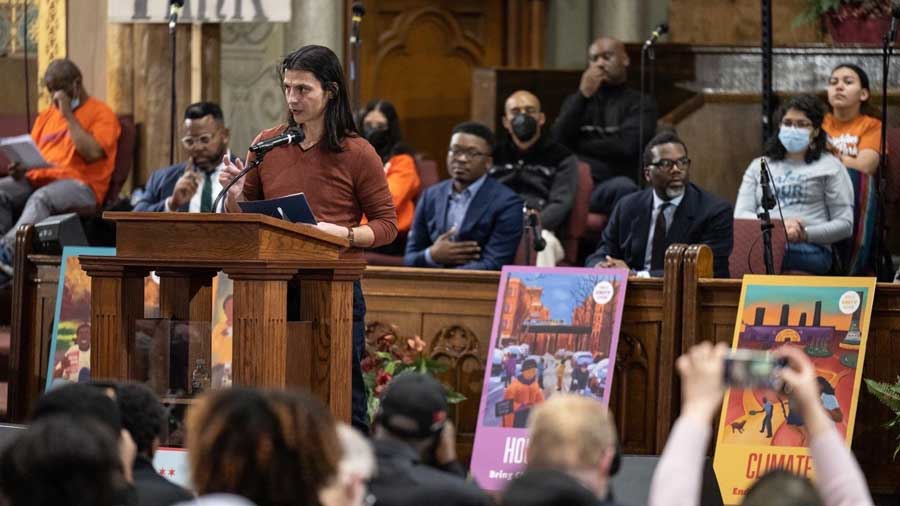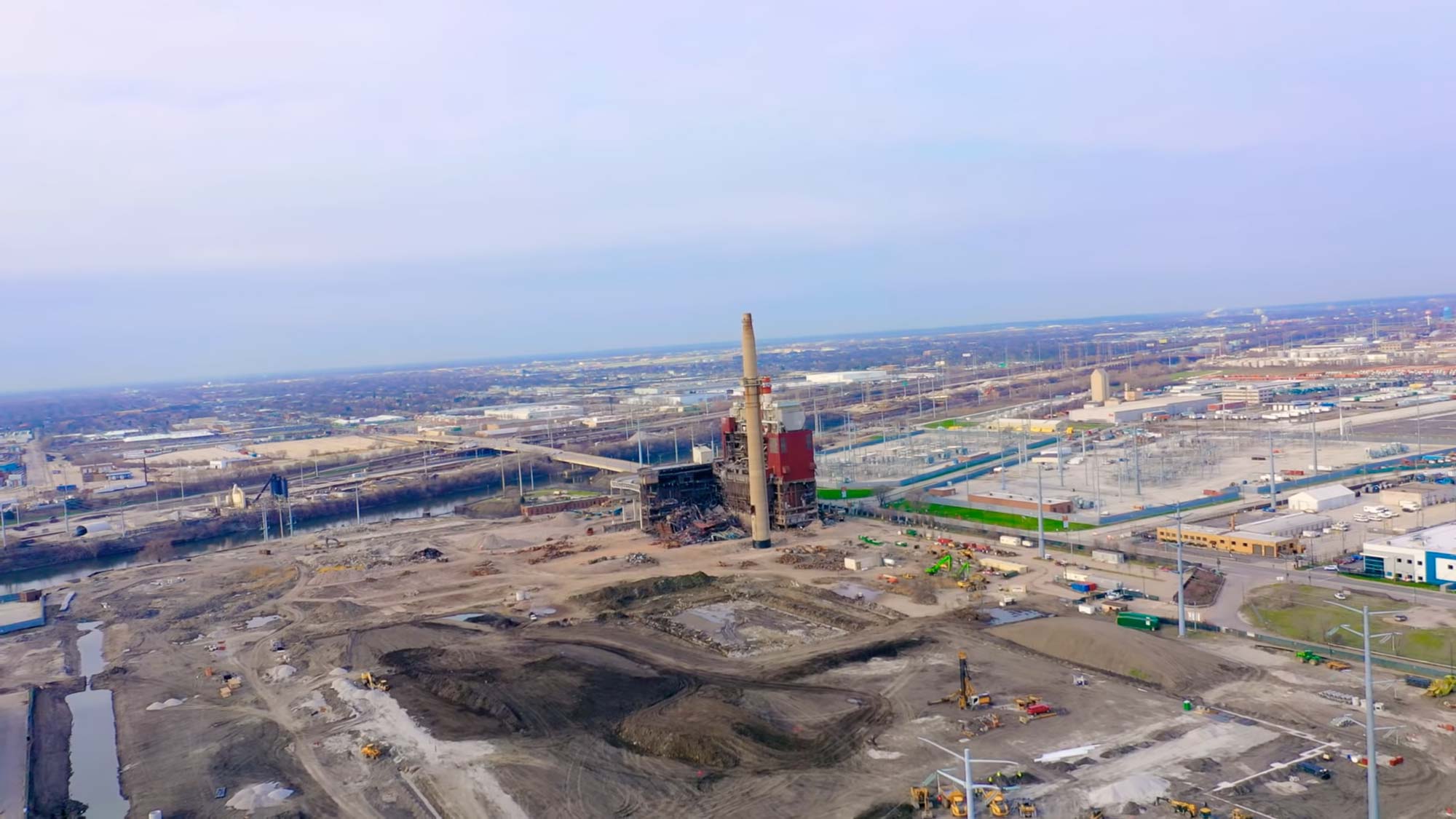Chicago Environmental Justice Network brings together women of color-led environmental movements.
The people of Chicago’s Little Village neighborhood thought they were safe from the nearby coal-fired power station after its towering smokestack—among the dirtiest in the country—closed in 2012.
Eight years later, a developer botched the demolition of the nearly 400-foot chimney, sending a colossal cloud of dust over a neighborhood that is a center of Mexican culture and community in Chicago, second only in size to the Mexican community of East Los Angeles.
Video by Alejandro Reyes
“I will never forget that day,” said Kim Wasserman, who grew up in the neighborhood. “I don’t even have words for it. It was absolutely horrific.”
Wasserman is Executive Director of the Little Village Environmental Justice Organization (LVEJO), which campaigned for stricter pollution controls that led to the closure of the Crawford Power Plant coal station. LVEJO continues to fight for justice on the same site as the smokestack catastrophe. Today, the organization is working to reduce the negative environmental impact of an e-commerce warehouse, which was built on the power plant site and is drawing hundreds of diesel-spewing trucks to the area.
The coal station and warehouse exemplify how polluting industries are overburdening Chicago’s Black and Latino communities, creating significant impacts on health and climate. For decades, the communities also bore the heaviest burden when highways and rail lines were built through the neighborhoods while public transit there was reduced.
Starting around 2011, Wasserman’s organization banded together with four other neighborhood groups to form the Chicago Environmental Justice Network (CEJN). Together, they pool resources to address industrial projects and structural environmental injustices across the South and West Sides—communities facing severe environmental and health disparities due to their proximity to pollution sources.
CEJN amplifies the voices of women of color in the environmental justice movement—women who, as Wasserman said, were brought into the cause out of necessity. For Wasserman, that moment came in 1998, when her oldest son was diagnosed with asthma at 3 months old.
“If you look across social justice movements, the role that women play has continually been one of stepping up for our communities,” she said. “Who's on the frontline of climate change? It's usually low-income communities of color. And who is at the frontline of fighting back? Ninety percent of the time, it’s women of color.”
A Lesson Learned: Be Nimble, Listen to Young People
Among its most high-profile successes, CEJN in 2022 helped stop the city from permitting construction of a metal shredding facility seeking to relocate to the already heavily industrialized Southeast Side after being forced out of the affluent Lincoln Park neighborhood. The company is appealing, but the network’s campaign to block permitting of the facility—including a hunger strike and successful civil rights complaint—has drawn attention to environmental racism in Chicago.
The campaign almost did not happen. It was launched in 2020, when the pandemic prevented organizers from going door-to-door.
“We thought we were going to lose,” said Olga Bautista, director of the Southeast Environmental Task Force, a CJEN member. When a group of determined high school students stepped up and organized online, the task force let them take the lead, supporting the students with funds for food, bull horns, even marching bands that turned out at rallies.
The lesson for the Task Force and the rest of CEJN was to be nimble and listen to young people.
“I can't tell you how inspiring and important this campaign has been for me,” Bautista said. “It gave me hope that it is possible to win these campaigns; not only possible but necessary.”
Wasserman also appreciates the importance of young peoples’ participation.
“They are the reason I get up and do this work,” she said. “I have a responsibility to leave them a world hopefully better than the one I inherited.”
Another member organization, Neighbors for Environmental Justice, played a key role in Chicago postponing a bid in 2022 for more than $500 million in city work led by an asphalt maker in the McKinley Park neighborhood that has drawn pollution complaints for years.

Neighbors for Environmental Justice, a member of the Chicago Environmental Justice Network, played a key role in postponing more than $500 million in city work led by an asphalt maker in the McKinley Park neighborhood that has drawn pollution complaints. Photo by: Neighbors for Environmental Justice.
The other two CEJN groups are Blacks in Green and People for Community Recovery, whose late founder, Hazel Johnson, is considered the mother of the environmental justice movement for her fight against what she called the “toxic donut” of industry surrounding public housing projects.
Holistic Strategy Rooted in Data
CEJN’s one-issue-at-a-time approach led members to consider the need for a more holistic strategy. The result was what may be the group’s most far-reaching achievement: a data-driven analysis of the cumulative environmental burdens in neighborhoods where CEJN works. Developed in 2018 and 2019 with support from the Natural Resources Defense Council, the report includes a mapping analysis that shows those neighborhoods are in the areas of highest pollution burdens and deepest socioeconomic vulnerability.
CEJN is using the report to push the city to change land use and zoning policies through a cumulative burden ordinance that would limit the number of polluting industries in a given area.

Alfredo Romo, Executive Director of Neighbors for Environmental Justice, has been a vocal advocate for community involvement in zoning and land use issues in Chicago. Photo by: Chicago Environmental Justice Network.
Another example of its more comprehensive approach is happening behind the scenes, where CEJN is addressing funding disparities faced by grassroots environmental justice groups in marginalized communities. In 2020 CEJN formed the Chicago Frontlines Funding Initiative to support its member organizations and others.
“Environmental justice groups receive a trickle of the grantmaking taking place,” said Antonio Lopez, Director of the funding initiative. “We're trying to be a solution to that.”
Looking ahead, CEJN is setting its sights on Chicago’s lead water lines, the issue of water affordability, and food justice, among other issues.
“It might feel a lot of times like we're isolated, but there are thousands of communities out there that are fighting the same battles,” Wasserman said. “And being able to learn from each other is what has truly made us as effective as we are today.”
Between 2020 and 2022, McArthur provided $4.025 million to support professional development, advocacy, policy, and management capacities at the Chicago Environmental Justice Network through its lead organization, Little Village Environmental Justice Organization.




